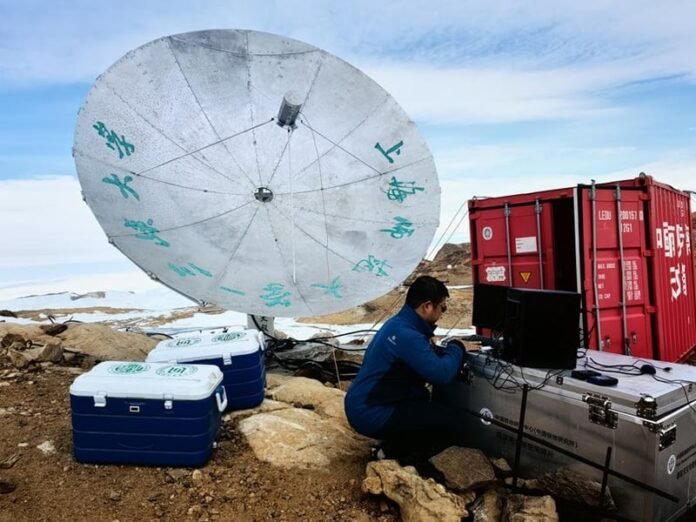
In a place where the wind screams across endless white deserts and the sun disappears for months at a time, a new eye has opened—one that doesn’t blink, doesn’t sleep, and gazes endlessly into the universe. Welcome to Zhongshan Station, Antarctica, where China has just inaugurated one of its boldest scientific ventures yet: the Three Gorges Antarctic Eye, a 3.2-meter radio/millimetre-wave telescope designed to unravel the secrets of star birth and the vast clouds of gas that cradle them.
A Telescope at the Edge of the World
Antarctica is perhaps the most unlikely place you’d imagine setting up a delicate scientific instrument. But that’s precisely why it’s perfect. With its ultra-clear skies, dry atmosphere, and near-zero light pollution, Earth’s southernmost continent offers a window into the cosmos unlike any other.
Co-developed by China Three Gorges University and Shanghai Normal University, the Three Gorges Antarctic Eye builds on China’s previous Antarctic Survey Telescopes (AST3). But this new instrument is a leap forward. Its mission? To listen in on the quiet whispers of the galaxy—the spectral lines of hydrogen and ammonia—to better understand how stars are born, evolve, and shape the universe.
Engineering in Extremes
Building anything in Antarctica is an exercise in patience, perseverance, and mind-boggling logistics. Constructing a cutting-edge telescope? That’s next level.
Engineers had to ensure the telescope could survive temperatures that plunge below –50°C and withstand wind speeds that could flatten a truck. Every wire, lens, and motor had to be redesigned, ruggedized, and rigorously tested to function in an environment that humans can barely survive in, let alone thrive.
But those hardships have paid off. The telescope now stands proud and ready, built to endure the harshest conditions on Earth to uncover the most delicate phenomena in space.
The Science: Cosmic Cradles and Galactic Gas
At its core, the Three Gorges Antarctic Eye is designed to observe neutral hydrogen (HI) and ammonia (NH₃)—two key markers in the vast nurseries where stars are born. By mapping and analyzing these gases, scientists aim to piece together a clearer picture of the star formation process, galactic structure, and the life cycles of cosmic matter.
This data will not only further China’s own astronomical ambitions, but also contribute to the global scientific community’s efforts to decode the mysteries of our galaxy.
Antarctica: Earth’s Natural Observatory
Antarctica isn’t just a place for penguins and polar explorers—it’s fast becoming a frontier for astronomy. With its clean, dry atmosphere and extended periods of darkness, it provides near-perfect conditions for observing the universe in wavelengths that are blocked or distorted elsewhere on Earth.
China’s expansion into Antarctic astronomy puts it in league with other nations investing in cutting-edge polar observatories, such as the IceCube Neutrino Observatory at the South Pole, which listens for ghostly particles from exploding stars.
Academic Ambitions & Future Endeavours
This isn’t just a government-backed initiative; it’s also a call to the country’s scientific institutions. China Three Gorges University plans to send regular research teams to Zhongshan Station to carry out on-site investigations and experiments. The telescope will act as a beacon for academic collaboration, innovation, and hands-on learning in extreme conditions.
With time, this initiative could open doors to more powerful submillimeter-wave observatories, turning the barren ice fields into bustling hubs of interstellar insight.
A Global Chorus of Cosmic Listening
The Three Gorges Antarctic Eye joins a growing symphony of observatories around the world listening to the universe in new and exciting ways:
- INO (India-based Neutrino Observatory) – Peering into the world of neutrinos deep beneath Tamil Nadu’s mountains.
- IceCube (USA) – Catching elusive neutrinos as they whiz through frozen Antarctic ice.
- JUNO (China) – Preparing to detect solar and geoneutrinos from its underground lair.
- DUNE (USA) – A next-gen neutrino experiment set to uncover the secrets of supernovae by 2030.
- TRIDENT (South China Sea) – A deep-sea telescope diving into the unknown world of aquatic neutrino interactions.
Each of these observatories is like a unique musical instrument in an orchestra, together composing humanity’s grand symphony of cosmic discovery.
The Bigger Picture: Gazing Up, Grounded in Hope
In an age when Earth feels increasingly small and divided, the act of looking up—of pushing into the unknown together—remains a quietly revolutionary thing.
China’s Three Gorges Antarctic Eye isn’t just a marvel of science and engineering; it’s a statement of intent. A declaration that even from the coldest, loneliest corners of the planet, we can reach for the stars.

